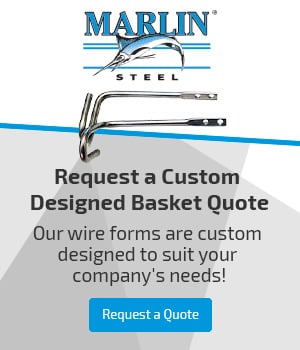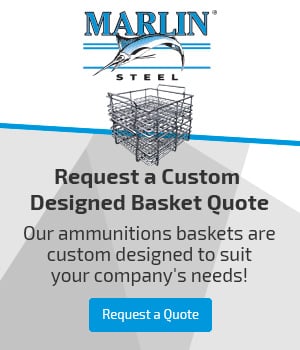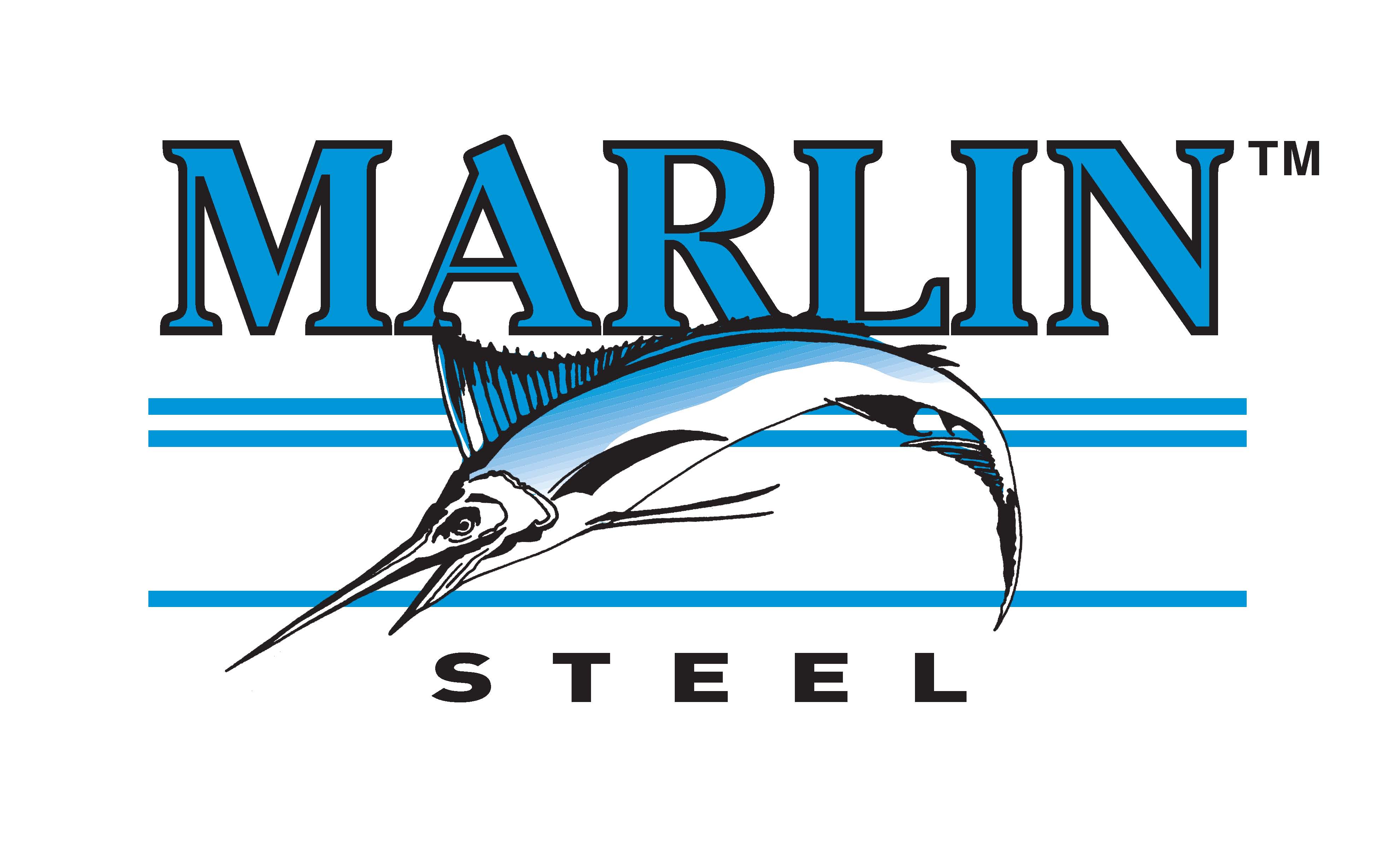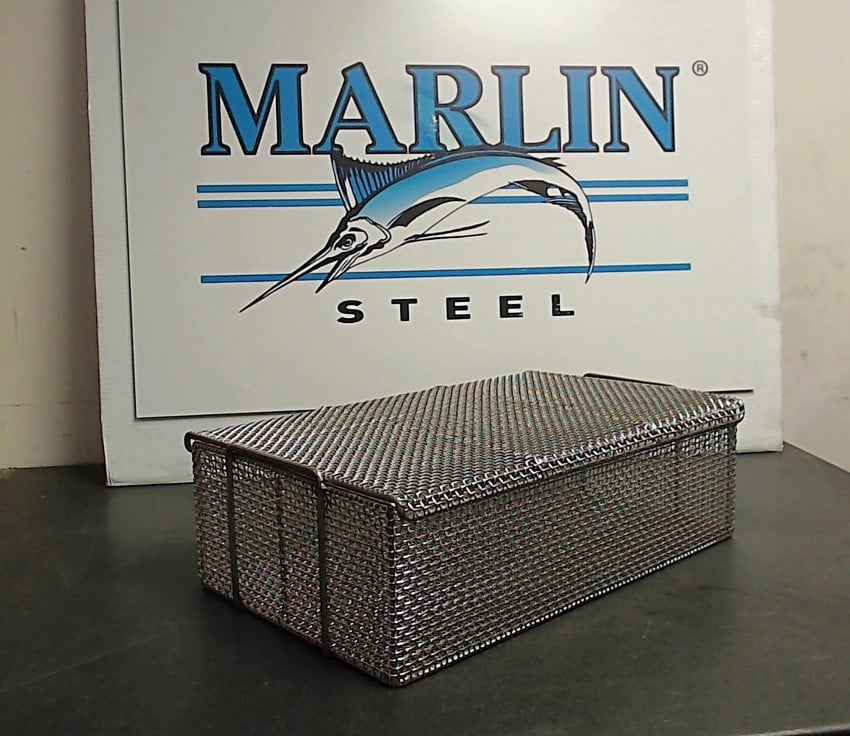
There are countless variations of stainless steel (SS) that you could potentially use for a custom wire tray or basket. Each stainless steel alloy formulation possesses its own unique properties for melting point, tensile strength, and corrosion or oxidation resistance.
Picking the proper stainless steel grade requires knowing what your options are. To help you better understand your choices, here’s a quick explanation of the most common varieties of stainless steel and their individual properties.
Five Primary Stainless Steel Categories
While there are thousands of different alloys of stainless steel, they can all be divided into broad categories:
- Austenitic Stainless Steels. The most frequently used, austenitic stainless steels tend to have a higher amount of chromium compared to other steel alloys, giving them a higher resistance to corrosion. They're also generally non-magnetic alloys, though cold working can change that.
- Ferritic Stainless Steels. As their name suggests, these stainless steel alloys are magnetic. They're also the second most common stainless steel after austenitic varieties. Manufacturers can harden these alloys using cold working techniques. Ferritic stainless steels are often less expensive, as well, due to the reduced nickel content in their makeup.
- Martensitic Stainless Steels. This is the least common category of stainless steel alloys. The corrosion resistance of austenitic and ferritic alloys is typically higher, but martensitic stainless steels possess high hardness. These alloys are often ideal for applications necessitating exceptionally high tensile strength and resistance to impact. When an application also requires resistance to corrosive substances, martensitic stainless steels are usable once they've received a polymer coating for enhanced surface protection.
- Duplex (Ferritic-Austenitic) Stainless Steels. This stainless steel category gets its name from the material's composition, which is half austenite and half delta-ferrite. With a higher tensile strength than typical austenitic varieties, duplex stainless steels express better resistance to corrosion and chloride pitting. Given their physical properties and resistance to chemicals, duplex stainless steels are commonly found in pipelines or piping systems for the oil and gas sector or pressure vessels within the petrochemical market.
- Precipitation-Hardening (PH) Stainless Steels. This stainless steel category is made up of corrosion-resistant, durable, exceptionally strong alloys. Manufacturers can treat PH stainless steels to yield strengths up to four times that of standard austenitic alloys. They're a common occurrence in nuclear, oil and gas, and aerospace industries.
There are numerous grades of stainless steel within each category — here are the breakdowns of the most common varieties of each.
Common Types of Austenitic Stainless Steels
Grade 301 Stainless Steel
The composition of grade 301 SS includes additions of nickel and chromium. It's both ductile and strong after cold working and offers exceptional resistance to corrosion. With such properties, this grade of stainless steel has common applications in drawing, forming, and welding.
Grade 302 Stainless Steel
While it has a similar composition to grade 304 SS, grade 302 contains higher levels of carbon. It's particularly useful for its resistance to corrosion when exposed to chemicals, acids, and solvents. Grade 302 SS is a good material choice for conical compression springs, as well as food processing and kitchen equipment.
Grade 303 Stainless Steel
This non-magnetic alloy is among the best of the austenitic stainless steels regarding its machinability. It isn't hardenable through heat treatment. Also, while not as resistant as grade 304, this stainless steel variety is a corrosion-resistant metal. The grade is applicable for gears, shafts, screws, nuts, bolts, and other heavily machined components.
Grade 304 Stainless Steel
The most common stainless steel type, grade 304 is one that Marlin Steel uses often in our custom wire baskets due to its versatility. Even compared to steel alloys, grade 304 SS is notable for its impressive tensile strength, which is about 621 MPa, or 90 ksi. Similar to other stainless steel varieties, grade 304 has a high maximum operating temperature of about 870 °C. Combining high tensile strength with corrosion and temperature resistance makes this stainless steel grade perfect for myriad applications.
Grade 309 Stainless Steel
This nickel-chromium alloy shares grade 304's machinability, with high tensile strength and resistance to chemicals and high temperatures. Grade 309 SS is commonly found in everything from furnace parts and oven linings to automotive exhaust components and aircraft engines, as well as other high-heat applications.
Grade 316 Stainless Steel
Another common austenitic stainless steel, grade 316 stainless possesses a range of benefits, with a 579 MPa (84 ksi) tensile strength and a maximum use temperature of approximately 800 °C (1,472 °F). While its tensile strength and temperature tolerance are lower compared to grade 304 SS, grade 316 stainless exhibits superior chloride resistance to substances, making it an ideal option for marine applications or projects that involve salt exposure.
Grade 317 Stainless Steel
Like the previously discussed austenitic stainless steel varieties, grade 317 SS has high corrosion resistance and tensile strength, with its high composition of chromium and nickel. However, the alloy also includes molybdenum, which enhances its pitting resistance against chlorides. By avoiding pitting, this grade is great for the marine and chemical processing market sectors, though it does come at a higher price compared to similar stainless steel options.
Grade 321 Stainless Steel
With added titanium in its composition, non-magnetic grade 321 SS can better withstand high temperatures and chemical-induced corrosion. The alloy can also resist oxidation in environments of up to 1,500 °F and retains its strength in cold temperatures. The material's properties regarding stress ruptures exceed those of grade 304 SS.
Grade 347 Stainless Steel
The makeup of this non-magnetic stainless steel alloy includes tantalum and columbium, so it's better able to retain its durability when exposed to high temperatures. It's perfect for applications like welding when there'll be intermittent heating in the 800 °F and 1,650 °F range. Somewhat ductile, grade 347 can be stamped, drawn, and spun, as needed.
Ferritic Stainless Steel — Affordable, Magnetic Stainless Option
Grade 405 Stainless Steel
With less resistance to corrosion than grade 430 SS, grade 405 is better suited to environments that are only mildly corrosive. With additional aluminium in its composition, this alloy won't harden when cooled post-welding. It's a useful alloy for steam nozzles, quenching racks, and various related applications.
Grade 408 Stainless Steel
Grade 408 SS is highly resistant to heat, but not corrosion. It contains a combination of 8% nickel and 11% chromium.
Grade 409 Stainless Steel
With corrosion-resistant properties and a tolerance for high heat, grade 409 SS offers particular resistance against atmospheric corrosion and exhaust gas — though it isn't as resistant to corrosion as grade 430. As such, grade 409 SS is common for exhaust systems and similar automotive applications.
Grade 420 Stainless Steel
Of all the stainless steel grades, grade 420 possesses the highest hardness (up to 50HRC), with 12% chromium. Grade 420 SS also exhibits good corrosion resistance and ductility, particularly when exposed to foods, fresh water, mild acids, or alkalis. It's a common choice for cutlery for this reason, though it may experience pitting if continually exposed to some food compounds.
Grade 430 Stainless Steel
While it doesn't have the strength of the above austenitic stainless steels, grade 430 SS does exhibit good resistance to nitric acid. It's still sufficiently strong for heavy-duty applications, though its 450 MPa tensile strength (65 ksi) is lower than that of most austenitic alloys.
Grade 434 Stainless Steel
The stronger alternative to grade 430 stainless, 434 stainless has a 540 MPa (78 ksi) tensile strength. It can handle operating temperatures at a maximum of 815 °C (1,499 °F). This makes grade 434 stainless steel slightly better for high-heat applications than 316 stainless, while being tougher than grade 430 stainless. Grade 434 also has exceptional resistance against pitting when compared to grade 430.
Grade 436 Stainless Steel
A modified grade 434, grade 436 SS has added molybdenum and columbium, which reduces any roping or riding in stretch forming. Grade 436 is fairly resistant to abrasion and very magnetic. Typical usage ranges from automotive parts to appliance trim.
Grade 444 Stainless Steel
Grade 444 SS is a low-carbon stainless steel with molybdenum content that provides good resistance to oxidation and pitting. With properties ranging from high strength to good ductility, Grade 444 can be formed with myriad stretch-bending processes. That said, the weldability of this stainless steel grade is somewhat limited. Applications best suited for grade 444 stainless steel include roofing and coating in marine environment and food processing applications.
Martensitic Stainless Steel — High Strength and Hardness
Grade 410 Stainless Steel
A general-purpose martensitic alloy, grade 410 offers corrosion-resistant abilities that manufacturers can enhance with hardening, tempering, and polishing treatments. Though austenitic steels are more resistant to corrosion, martensitic stainless steel alloys such as grade 410 still maintain ideal performance under mildly corrosive conditions.
Grade 410S Stainless Steel
Grade 410S is a low-carbon variation of grade 410. It's non-hardening, even under high-heat conditions. It will keep its softness and ductility in spite of any rapid fluctuations in temperature, which prevents cracking in high-temperature environments or during welding operations. This stainless steel is often used in petrochemical applications like petroleum refining or thermal processing.
Grade 414 Stainless Steel
This stainless steel is essentially grade 410 with the addition of nickel. This additional nickel content makes grade 414 stronger than similar thicknesses of grade 410. This grade is common in forged shafts, beater bars, spindles, valve seats, fasteners, and other mining equipment components
Grade 416 Stainless Steel
With a machinability of 85%, grade 416 SS offers the highest degree of machinability of any stainless steel. Due to this property and its low cost, grade 416 stainless steel comes in a variety of forms, such as hardened, unhardened, or highly tempered. Grade 416 is less resistant to corrosion than austenitic steels, though grade 416 delivers great resistance against fresh water, alkalis, and acids. Popular applications range from bolts and gears to automatic screw-machined parts and washing machine components.
Grade 420 Stainless Steel
When impact resistance and tensile strength are of primary importance in an application, grade 420 SS is an ideal choice. Its tensile strength is approximately 586 MPa, or 85 ksi, once annealed. That tensile strength can increase to about 1,586 MPa, or 230 ksi, through hardening and stress-relieving processes. It doesn't offer the same resistance to chemicals as austenitic and ferritic varieties, but grade 420 SS is sufficiently resistant to food compounds, water, mild acids, and certain alkalis, lending it to applications as cutlery.
Grade 440 Stainless Steel
The high carbon content in grade 440 SS allows for effective heat treating. This enhances its resistance to wear as well as its ability to retain a cutting edge. Grade 440 stainless steel is a magnetic alloy and has average resistance to corrosive substances. Common uses include anything from scissors and knives to components that undergo oil or gas exposure.
Duplex Stainless Steels — Balanced Strength and Corrosion Resistance
Grade 2205 Stainless Steel
Due to its nitrogen content, grade 2205 SS offers impressive resistance to pitting, crevice corrosion, and stress corrosion cracking. This enables grade 2205 to have almost two times the corrosion resistance found in other austenitic materials. Marine, petrochemical, oil and gas, and pulp and page industries find use in grade 2205 in applications requiring significant strength and strong corrosion resistance.
Grade 2304 Stainless Steel
Though it has the same corrosion resistance as grade 316 SS, grade 2304 has nearly twice the yield strength of grade 316 and other austenitic steels. It can also perform admirably in colder environments, though with some exceptions. This material is ideally suited to applications in the range of -58 °F to 572 °F.
Grade 2507 Stainless Steel
This duplex stainless steel has strong chloride stress corrosion resistance, high thermal conductivity, and a low thermal expansion coefficient. Grade 2507 is compatible with applications requiring high tensile strength and supreme corrosion resistance. Applications that use grade 2507 SS include structural or mechanical components for marine, offshore oil platforms, and petrochemical equipment.
Precipitation-Hardening Stainless Steels — Ideal for Aerospace and Nuclear Applications
Grade 17-4 Stainless Steel
This precipitation-hardening stainless steel has both impressive strength and fair corrosion resistance. The degree of strength in grade 17-4 can be manipulated with heat treatment. It also possesses magnetic properties and average machinability. Common uses for grade 17-4 include applications in the aerospace, chemical, and petroleum markets.
Grade 15-5 Stainless Steel
This stainless steel grade boasts high strength and corrosion resistance, as well as transverse toughness, ductility, and hardness capability. It isn't an ideal material for cold working, though it's suitable for hot working. This PH stainless steel is commonly utilized in corrosive, high-pressure environments and is ideal for aerospace parts.
Table: Stainless Steel Alloy Characteristics
Here’s a stainless steel grade chart to break down the characteristics of the alloys listed above:
| Alloy |
Tensile Strength |
Maximum Use Temp |
Melting Point |
Resistance |
|
Austenitic Alloys |
|
|
|
|
|
Grade 301 Stainless |
515 MPa (75 Ksi) |
871 °C (1600 °F) |
1399-1421°C (2550-2590°F) |
Excellent corrosion resistance |
|
Grade 302 Stainless |
585 MPa (85 Ksi) |
870˚C (1,679˚F) |
1400-1420 °C (2550-2590 °F) |
Excellent corrosion resistance |
|
Grade 303 Stainless Steel |
690 MPa ( 100 Ksi) |
760˚C (1,400˚F) |
1400-1420 °C (2550-2590 °F) |
Lower corrosion resistance |
|
Grade 304 Stainless |
621 MPa (90 Ksi) |
870˚C (1,679˚F) |
1,399 – 1,454˚C (2,550 – 2,650˚F) |
Good overall resistance to corrosives |
|
Grade 309 Stainless |
620 MPa (89 Ksi) |
1000˚C (1,832˚F) |
1400-1455 °C (2550-2651 °F) |
Excellent corrosion resistance |
|
Grade 316 Stainless |
579 MPa (84 ksi) |
~800˚C (1,472˚F) |
1,371 – 1,399˚C (2,500 – 2,550˚F) |
Excellent chloride resistance |
|
Grade 317 Stainless |
585 MPa ( 85 Ksi) |
816˚C (1,500˚F) |
1,370 – 1,400˚C (2,500 – 2,550˚F) |
Good chloride resistance |
|
Grade 321 Stainless |
620 MPa (90Ksi) |
816˚C (1,500˚F) |
1,400 – 1,425˚C (2,550 – 2,600˚F) |
Excellent corrosion resistance |
|
Grade 347 Stainless |
690 MPa (101 Ksi) |
816˚C (1,500˚F) |
1,400 – 1,425˚C (2,550 – 2,600˚F) |
Excellent corrosion resistance |
|
Ferritic Alloys |
|
|
|
|
|
Grade 405 Stainless |
585 MPa (85Ksi) |
815˚C (1,499˚F) |
1,480 – 1,530˚C (2,700 – 2,790˚F) |
Good acid corrosion resistance |
|
Grade 408 Stainless |
505 MPa (73 Ksi) |
815˚C (1,499˚F) |
1,400 – 1,455˚C (2,550 – 2,650˚F) |
Resists well against most oxidizing acids and salt spray |
|
Grade 409 Stainless |
448MPa (65 Ksi) |
815˚C (1,499˚F) |
1,425 – 1,510˚C (2,597 – 2,750 F) |
Good corrosion resistance |
|
Grade 420 Stainless |
760 - 1702 MPa (110 - 247 Ksi) |
427˚C (800˚F) |
1,455 – 1,510˚C (2,651 – 2,750 F) |
Fairly corrosion resistant |
|
Grade 430 Stainless |
450 MPa (65 ksi) |
815˚C (1,499˚F) |
1,425 – 1,510˚C (2,597 – 2750˚F) |
Good nitric acid resistance |
|
Grade 434 Stainless |
540 MPa (78 ksi) |
815˚C (1,499˚F) |
1,426 – 1,510˚C (2,600 – 2750˚F) |
Superior pitting resistance |
|
Grade 436 Stainless |
459 MPa (67 Ksi) |
815˚C (1,499˚F) |
1,425 – 1,510˚C (2,600 – 2,750˚F) |
Excellent citric and nitric acid corrosion resistance |
|
Grade 442 Stainless |
515-550 MPa (77 - 80Ksi) |
925-980˚C (1,700/1,800˚F) |
1,065 – 1,120˚C (1,950 – 1,120˚F) |
Good corrosion resistance |
|
Grade 444 Stainless |
415 MPa ( 60 Ksi) |
950˚C (1,752˚F) |
1,405 – 1,495˚C (2,561 – 2,723˚F) |
Good oxidation resistance |
|
Martensitic Alloy |
|
|
|
|
|
Grade 410 Stainless |
500 -1400 MPa (73 - 203 Ksi) |
650˚C (1,202˚F) |
1,482 – 1,532˚C (2,700 – 2,790˚F) |
Good corrosion resistance to air, water, and some chemicals |
|
Grade 410S Stainless |
444 MPa (64 Ksi) |
705˚C (1,300˚F) |
1,482 – 1,532˚C (2,700 – 2,790˚F) |
Good oxidation resistance |
|
Grade 416 Stainless |
517 MPa (75 Ksi) |
760˚C (1,400˚F) |
1,480 – 1,530˚C (2,696 – 2,786˚F) |
Poor Chloride resistance. Good resistance to acids, alkalis & fresh water |
|
Grade 420 Stainless |
586 MPa (85 ksi) when annealed |
650˚C (1,202˚F) |
1,454 – 1,510˚C (2,649 – 2,750˚F) |
Resistant to mild acids, alkalis, and water when hardened |
|
Grade 440 Stainless |
758 MPa (110 Ksi) |
760˚C (1,400˚F) |
1,483˚C ( 2,700˚F) |
Limited corrosion resistance |
|
Duplex (Ferritic-Austenitic) Alloys |
|
|
|
|
|
Grade 2205 Stainless |
620 MPa (90 Ksi) |
300˚C (572˚F) |
1,385 – 1,443˚C (2,525 – 2,630˚F) |
Excellent corrosion resistance |
|
Grade 2304 Stainless |
>600 MPa (>87 Ksi) |
570˚C (1058˚F) |
900 – 1,150˚C (1,650 – 2,100˚F) |
Resistance to corrosion cracking |
| Grade 2507 Stainless | 800 MPa (116 Ksi) | 300˚C (572˚F) | 1,350˚C (2,460˚F) | Excellent chloride corrosion resistance |
| Precipitation Hardening (PH) Alloys | ||||
| Grade 17-4 Stainless | 1103 MPa (160 Ksi) | 316˚C (600˚F) | 1,404 - 1,440˚C (2,560 - 2,625˚F) | Excellent corrosion resistance |
| Grade 15-5 Stainless | 1380 MPa (200 Ksi) | 316˚C (600˚F) | 1,404 - 1,440˚C (2,560 - 2,625˚F) | Excellent corrosion resistance |
Marlin Steel's Stainless Steel Solutions
Marlin Steel’s degreed engineers can create a large variety of wire forms and baskets to meet your needs, including custom S hooks, swaged pierced wire forms, and eye hooks, among others. These stainless steel forms can be crafted from a variety of the different steel options listed above, depending on your needs and application.
Your choice of stainless steel depends on your application. So, be sure to contact an experienced mechanical engineer, as they can make sure to deliver the best stainless steel solution.

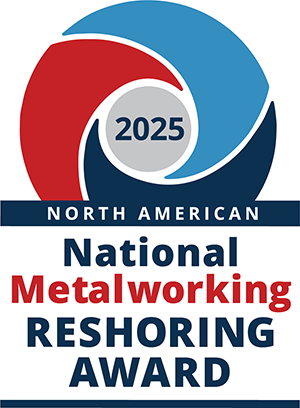






.gif)
